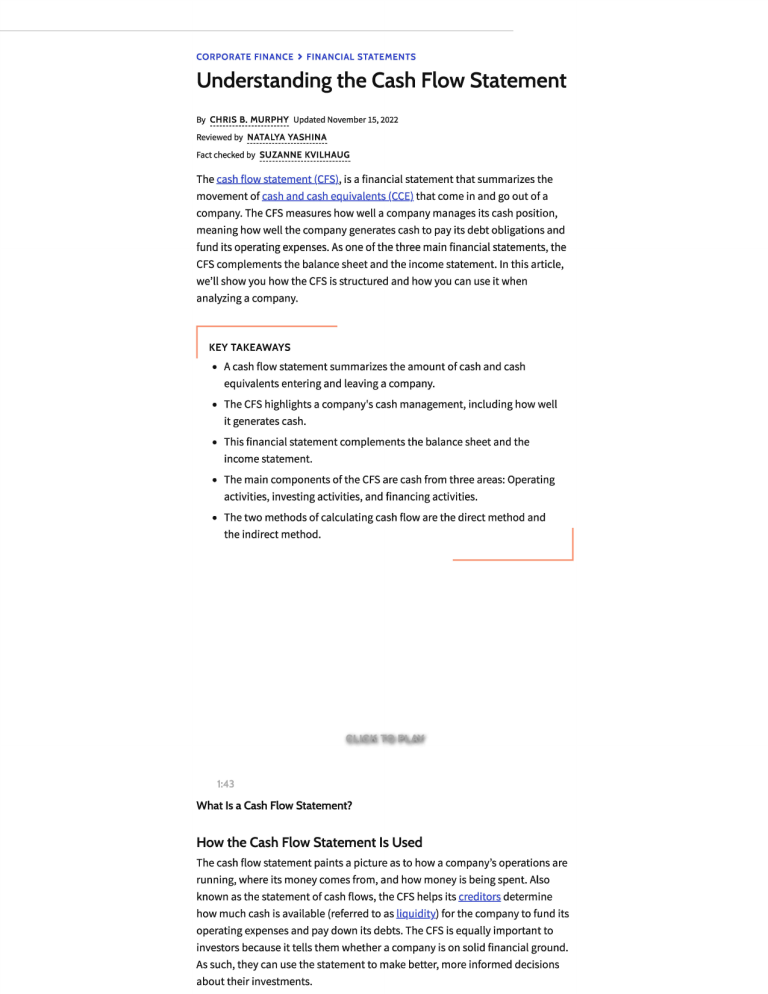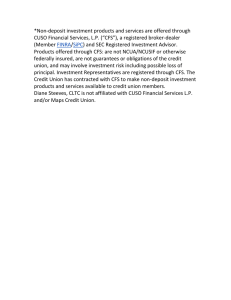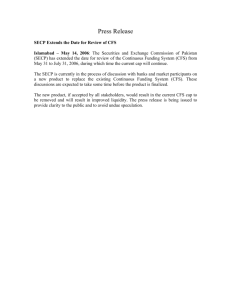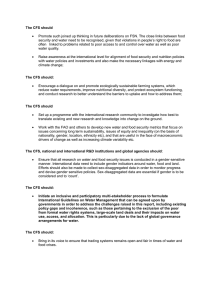
CORPORATE FINANCE > FINANCIAL STATEMENTS Understanding the Cash Flow Statement By CHRIS B. _MURPHY Updated November 15, 2022 Reviewed by NATALYA YASHINA Fact checked by SUZANNE KVILHAUG The cash flow statement (CTSL is a financial statement that summarizes the movement of cash and cash equivalents (CCE) that come in and go out of a company. The CFS measures how well a company manages its cash position, meaning how well the company generates cash to pay its debt obligations and fund its operating expenses. As one of the three main financial statements, the CFS complements the balance sheet and the income statement. In this article, we'll show you how the CFS is structured and how you can use it when analyzing a company. KEY TAKEAWAYS • A cash flow statement summarizes the amount of cash and cash equivalents entering and leaving a company. • The CFS highlights a company's cash management, including how well it generates cash. • This financial statement complements the balance sheet and the income statement. • The main components of the CFS are cash from three areas: Operating activities, investing activities, and financing activities. • The two methods of calculating cash flow are the direct method and the indirect method. 1:43 What Is a Cash Flow Statement? How the Cash Flow Statement Is Used The cash flow statement paints a picture as to how a company's operations are running, where its money comes from, and how money is being spent. Also known as the statement of cash flows, the CFS helps its creditors determine how much cash is available (referred to as liguiditY.) for the company to fund its operating expenses and pay down its debts. The CFS is equally important to investors because it tells them whether a company is on solid financial ground. As such, they can use the statement to make better, more informed decisions about their investments. 1. cash flow from op.frating activities 2. Cash flow from investing activities 3. Cash flow from financing activities 4. Disclosure of non-cash activities, which is sometimes included when prepared under ge.nera.l.Jy....afilpted accounting princiiws (GAAP).. [ll Cash from Operating Activities The .op_e_rating activities on the CFS include any sources and uses of cash from business activities. In other words, it reflects how much cash is generated from a company's products or services. These operating activities might include: • Receipts from sales of goods and services • Interest payments • Income tax payments • Payments made to suppliers of goods and services used in production • Salary and wage payments to employees • Rent payments • Any other type of operating expenses In the case of a trading portfolio or an investment company, receipts from the sale of loans, debt, or _gg.!J.i1Y. instruments are also included because it is a business activity. Important: Changes made in cash, accounts receivable, depreciation, inventory, and accounts payable are generally reflected in cash from operations. Cash from Investing Activities Investing activities include any sources and uses of cash from a company's investments. Purchases or sales of assets, loans made to vendors or received from customers, or any payments related to JI!filgers and acquisitions (M.Ml are included in this category. In short, changes in equipment, assets, or investments relate to cash from investing. Changes in cash from investing are usually considered cash-out items because cash is used to buy new equipment, buildings, or short-term assets such as marketable securities. But when a company divests an asset, the transaction is considered cash-in for calculating cash from investing. Cash from Financing Activities Cash from financing activities includes the sources of cash from investors and banks, as well as the way cash is paid to shareholders. This includes any dividends, payments for stock reP-urchases, and repayment of debt principal (loans) that are made by the company. Changes in cash from financing are cash-in when capital is raised and cash-out when dividends are paid. Thus, if a company issues a bond to the public, the company receives cash financing. However, when interest is paid to bondholders, the company is reducing its cash. And remember, although interest is a cash-out expense, it is reported as an operating activity-not a financing activity. · · ·- · - -· - -·· - · · · - - · · - - - - · · - - · - - · - - ·· • 0 - - - ·· ·· - ·· · · · · · - - · · - - - ···--·· --and the indirect method. Direct Cash Flow Method The direct method adds up all of the cash payments and receipts, including cash paid to suppliers, cash receipts from customers, and cash paid out in salaries. This method of CFS is easier for very small businesses that use the cash ~ accounting method. These figures can also be calculated by using the beginning and ending balances of a variety of asset and 1i..ahl1itY. accounts and examining the net decrease or increase in the accounts. It is presented in a straightforward manner. FAST FACT Most companies use the accrual basis accounting method. In these cases, revenue is recognized when it is earned rather than when it is received. This causes a disconnect between net income and actual cash flow because not all transactions in net income on the income statement involve actual cash items. Therefore, certain items must be reevaluated when calculating cash flow from operations. Indirect Cash Flow Method With the indirect method , cash flow is calculated by adjusting net income by adding or subtracting differences resulting from non-cash transactions. Noncash items show up in the changes to a company's assets and liabilities on the balance sheet from one period to the next. Therefore, the accountant will identify any increases and decreases to asset and liability accounts that need to be added back to or removed from the net income figure, in order to identify an accurate cash inflow or outflow. Changes in accounts receivable (AR). on the balance sheet from one accounting 12eriod to the next must be reflected in cash flow: • If AR decreases, more cash may have entered the company from customers paying off their credit accounts-the amount by which AR has decreased is then added to net earnings. • An increase in AR must be deducted from net earnings because, although the amounts represented in AR are in revenue, they are not cash. What about changes in a company's inventory? Here's how they are accounted for on the CFS: • An increase in inventory signals that a company spent more money on raw materials. Using cash means the increase in the inventory's value is deducted from net earnings. • A decrease in inventory would be added to net earnings. Credit purchases are reflected by an increase in accounts payable on the balance sheet, and the amount of the increase from one year to the next is added to net earnings. The same logic holds true for taxes payable, salaries, and ~paid insurance. If something has been paid off, then the difference in the value owed from one year to the next has to be subtracted from net income. If there is an amount that is still owed, then any differences will have to be added to net earnings. · ·-o-·· · - ---·· ··- ·· - ·· --·- ·· ------ ·· ·--·--··, ·- ·-- - = e . . . . .. __ tfurther analysis. Poor cash flow is sometimes the result of a company's decision to expand its business at a certain point in time, which would be a good thing for the future. Analyzing changes in cash flow from one period to the next gives the investor a better idea of how the company is performing, and whether a company may be on the brink of bankrui;lkY. or success. The CFS should also be considered in unison with the other two financial statements (see below). FAST FACT The indirect cash flow method allows for a reconciliation between two other financial statements: the income statement and balance sheet. Cash Flow Statement vs. Income Statement vs. Balance Sheet The cash flow statement measures the performance of a company over a period of time. But it is not as easily manipulated by the timing of non-cash transactions. As noted above, the CFS can be derived from the im;Q__m__e_ statement and the balance sheet. Net earnings from the income statement are the figure from which the information on the CFS is deduced. But they only factor into determining the operating activities section of the CFS. As such, net earnings have nothing to do with the investing or financial activities sections of the CFS. The income statement includes .depreciation expense, which doesn't actually have an associated cash outflow. It is simply an allocation of the cost of an asset over its useful life. A company has some leeway to choose its depreciation m.etho.d., which modifies the depreciation expense reported on the income statement. The CFS, on the other hand, is a measure of true inflows and outflows that cannot be as easily manipulated. As for the balance sheet, the net cash flow reported on the CFS should equal the net change in the various line items reported on the balance sheet. This excludes cash and cash equivalents and non-cash accounts, such as accumulated depreciation and accumulated amortization. For example, if you calculate cash flow for 2019, make sure you use 2018 and 2019 balance sheets. Tip: The CFS is distinct from the income statement and the balance sheet because it does not include the amount of future incoming and outgoing cash that has been recorded as revenues and expenses. Therefore, cash is not the same as net income, which includes cash sales as well as sales made on credit on the income statements. Example of a Cash Flow Statement Below is an example of a cash flow statement: ~ Image From this CFS, we can see that the net cash flow for the 2017 ~ & a r was $1,522,000. The bulk of the positive cash flow stems from cash earned from operations, which is a good sign for investors. It means that core operations are generating business and that there is enough money to buy new inventory. The purchasing of new equipment shows that the company has the cash to invest in itself. Finally, the amount of cash available to the company should ease investors' minds regarding the notes payable, as cash is plentiful to cover that future loan expense. What Is the Difference Between Direct and Indirect Cash Flow Statements? The difference lies in how the cash inflows and outflows are determined. Using the direct method, actual cash inflows and outflows are known amounts. The cash flow statement is reported in a straightforward manner, using cash payments and receipts. Using the indirect method, actual cash inflows and outflows do not have to be known. The indirect method begins with net income or loss from the income statement, then modifies the figure using balance sheet account increases and decreases, to compute implicit cash inflows and outflows. Is the Indirect Method of the Cash Flow Statement Better Than the Direct Method? Neither is necessarily better or worse. However, the indirect method also provides a means of reconciling items on the balance sheet to the net income on the income statement. As an accountant prepares the CFS using the indirect method, they can identify increases and decreases in the balance sheet that are the result of non-cash transactions. It is useful to see the impact and relationship that accounts on the balance sheet have to the net income on the income statement, and it can provide a better understanding of the financial statements as a whole. What Is Included in Cash and Cash Equivalents? Cash and cash equivalents are consolidated into a single line item on a company's balance sheet. It reports the value of a business's assets that are currently cash or can be converted into cash within a short period of time, commonly 90 days. Cash and cash equivalents include currency, petty cash, bank accounts, and other highly liquid, short-term investments. Examples of cash equivalents include commercial paper, Treasury bills, and short-term government bonds with a maturity of three months or less. The Bottom Line A cash flow statement is a valuable measure of strength, profitability, and the long-term future outlook of a company. The CFS can help determine whether a company has enough liquidity or cash to pay its expenses. A company can use a CFS to predict future cash flow, which helps with budgeting matters. For investors, the CFS reflects a company's financial health, since typically the more cash that's available for business operations, the better. However, this is not a rigid rule. Sometimes, a negative cash flow results from a company's growth strategy in the form of expanding its operations. , cash a well-being of a company. Get Your Investing "Starter Kit" Learn fundamental analysis strategies used by the most successful investors. This on line course by lnvestopedia Academy is taught by a CFA and CMT charter holder and includes over 67 lessons of on-demand video, exercises, and interactive content. You'll learn how to build an investment P-Ortfolio focused on creating real, long-term wealth and how to navigate Exchange Traded Funds, dividend stocks, and other trading instruments. Watch free trailer» ARTICLE SOURCES T PART OF Guide to Accounting CURRENTLY READIN G UP NEXT Understanding the Cash Flow Statement Breaking Down The Balance Sheet Income Statement: How to Read and Use It What Does an Accountant Do? Dut Rules, Skills, and His 24of 51 25 of 51 26of 51 27 of 51 ~ Ulll~\..U~IIILdUlt'.' rll'tAr,u... lAL::, IAI .t.M.t.N I::, Coffee Shop Cash Flow Statements: Reviewing Cash Flow From Waitress Counts Bill Operations Pavment !,~Balance Sheet FINANCIAL STATEMENTS Balance Sheet vs. Cash Flow Statement: What's the Difference? lJ i,,,a 1aptop screen showing charts and a person's hand TOOLS Examples of Cash Flow From Operating Activities FINANCIAL STATEMENTS Cash Flow Statement vs. Income Statement: What's the Difference? holding a paper lJ TOOLS How Do Net Income and Operating Cash Flow Differ? !,~Businessman FINANCIAL STATEMENTS Using Calculator Revenue vs. Retained Earnings: What's the Difference? Partner Links Related Terms Financial Statements: List of Types and How to Read Them Financial statements are written records that convey the business activities and the financial performance of a company. more Cash Flow From Operating Activities (CFO) Cash Flow From Operating Activities (CFO) indicates the amount of cash a company generates from its ongoing, regular business activities. more Cash Flow From Investing Activities Explained: Types and Examples Cash flow from investing activities reports the total change in a company's cash position from investment gains/losses and fixed asset investments. more Q. lalyze It 9 lnvestopedia into and out of a business. more Direct Method The direct method of creating the cash flow statement uses actual cash inflows and outflows from the company's operations, instead of accrual accounting inputs. ~ How To Use the Indirect Method To Prepare a Cash Flow Statement The indirect method uses changes in balance sheet accounts to modify the operating section of the cash flow statement from the accrual method to the cash method. ~ ~ RUSTe About Us Terms of Use Dictionary Editorial Policy Advertise News Privacy Policy Contact Us Careers Do Not Sell My Personal Information ~ &Sb Dotdosh V QRS> meredith lnvestopedia is part of the Dotdash Meredith publishing family.



